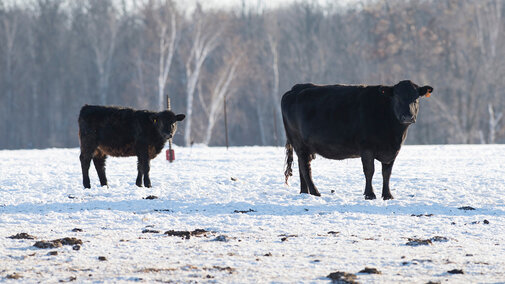Snow for Alfalfa
For alfalfa, snow is a winter gift, and the large winter storm that recently impacted most of western Nebraska brought anywhere from several inches to a few feet of the white stuff.
Snow helps alfalfa survive the winter. Plain and simple. A warm fall will allow some alfalfa to winterize very well and prepare for consistent cold temperatures. They do this by putting high concentrations of nutrients in the roots and crown to withstand temperatures down to 5 degrees.
Air temperature is colder than soil temperature. So even if the air is well below zero degrees, the soil will not be. With a layer of snow acting as insulation on the soil surface, the soil and roots of the alfalfa will be much warmer than bare soil and the air temperature. This layer of snow also protects the moisture in the roots and soil from being lost to evaporation. This is especially important with new seedings of alfalfa or alfalfa and grass mixtures which need to maintain root moisture. If the soil does dry out, desiccation, frost heaving and greater swings in soil temperature can result in higher levels of winterkill across a stand.
Having some stubble at the end of the growing season is a great way to catch this much-needed snow. If a late season harvest is unavoidable, cut high to ensure snow trapping stubble can still function. In an ideal situation, this snow insulation, winter hardy variety selection, and this is so important, alfalfa given the chance to properly winterize in the fall will keep winter kill to a minimum.
Snow is a great insulator and can help alfalfa and grasses survive winters. Even if you aren’t dreaming of a white Christmas, your alfalfa probably dreams for it every year.
Critical Cold Considerations for Cattle
By Brad Schick
Livestock performance and survival is affected by wind and temperature. When this occurs, is determined by the lower critical temperature (LCT), or the threshold at which point animals need to start using energy to maintain body heat. A cow with a body condition score of 5 with a dry coat will have a lower critical temperature of 19°F. When this happens, feed intake will need to increase to maintain a suitable body temperature and prevent a drop in body condition in the long run. This stress over time can erode animal condition and have severe impacts when it comes to breed back next year.
Moisture can have a bit more impact on LCTs. A cow with a wet coat will have a lower critical temperature of 53°F, instead of 19°F. Providing animals shelter in bad weather can help keep coats dry and limit wind chill effects, both of which will work to minimize the impact of the cold. Shelter can also help in other ways. Calving success can increase by 2% behind a windbreak, according to a Kansas study. In Montana, feedlots during severe winters, cattle behind windbreaks gained 10.6 lbs. more than cattle that did not have windbreaks.
With the situation Nebraska and surrounding states experienced in mid-December 2022, grass hay just doesn’t have enough energy to meet this uptick in demand. High quality alfalfa hay usually has a TDN of 58-60% and should meet requirements for dry, good condition animals at windchill temperatures down to -15°F.
When we get even colder, for an extended period, we might want to look at providing some additional supplement for energy. A general rule of thumb we can use is that for every degree of cold stress a cow faces, they increase their energy requirements by 1%. Corn is a great high-energy option, but we need to be careful to work it up in a diet slowly. Pair it with free choice hay for fill and make sure not give too much at once to animals whose rumen hasn’t shifted yet. If you have questions about adjusting animal diets to address cold weather stress, your local extension office is a great place to start.

